It is sin-like behavior to delay access to the searing and graceful wit of Alexandra DuPont, not only the best writer here on Coax, but in my view one of the best critics on the planet. The DVD Journal was good enough to loan her to us, so bow down, listen up, and be humbled as Cleopatra, predictably, discovers she is no match for Alexandria - er, that is, Alexandra the Great!
Review by Alexandra DuPont
"There is something about a mass-market Luxury Cruise that's unbearably sad."
— David Foster Wallace, "A Supposedly Fun Thing I'll Never Do Again"
I. Preamble
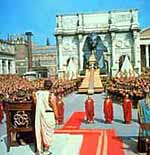 Cleopatra isn't a movie. It's a Super Bowl halftime show.
Cleopatra isn't a movie. It's a Super Bowl halftime show.
Actually, that's a little glib. What I should have written is: "It's a Super Bowl halftime show — only pathetic, because it has aspirations toward Art."
No, wait: "It's a Super Bowl halftime show — only pathetic, because it has aspirations toward Art — only not as pathetic (or dramatic) as its insanely troubled production history."
Actually, after viewing the more than 10 hours of material available on Fox's gorgeous, three-disc Cleopatra set, I realize that I could add clauses to the above phrase ad infinitum. Taken by itself, Cleopatra's just another bloated epic, albeit one of unprecedented scope. But throw in the film's production history — a deeply, deeply troubled production history, one that almost wrecked Fox in the early '60s and absolutely wrecked a few people's lives — and you can parse the film along social, ethical, and economic axes until your lower lip trembles.
Of course, taking a film's production history into account means writing about "social context," an approach that's usually best avoided; films should stand alone, you know? But this three-DVD set practically demands mention of Cleopatra's place in history: The special features relating to "social context" are quite a bit more interesting than the movie itself.
Yes, Cleopatra — much to the grave-rolling horror of its late director, the talented Joseph L. Mankiewicz (All About Eve, Guys and Dolls, The Ghost and Mrs. Muir, Sleuth) — has become famous for its infamy, not for its actual content, and that's the angle Fox seems to be taking in marketing this package. To which I write: Good! Budgeted at something like $200 million in today's dollars, the production was a tsunami of waste, conceit, and bowel-shaking career genocide that washed a certain breed of epic filmmaking right out of Hollywood in the early 1960s. From the near-revolt of its wigmakers to the stimulants that had to be given to Mankiewicz to keep him from collapsing to the petty arguments over who got to be on the billboard, the Making of Cleopatra is a killer tale — and it gets a killer treatment in the disc's extras, which I'll address below.
* * *
II. Still, let's spend a little time on the movie, shall we? Here's the story, with spoilers:
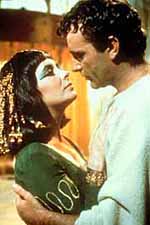 It's a two-act story (and one that Mankiewicz originally wanted to release in two three-hour installments; here we have the four-hour cut that was released to a handful of American theaters, though in the extras we're told that archivists are currently trying to assemble, good Lord, the six-hour version):
It's a two-act story (and one that Mankiewicz originally wanted to release in two three-hour installments; here we have the four-hour cut that was released to a handful of American theaters, though in the extras we're told that archivists are currently trying to assemble, good Lord, the six-hour version):
(1) Cleopatra (Elizabeth Taylor) and Caesar (Rex Harrison) fall in love. Cleopatra urges Caesar to focus on his career. Caesar goes bonkers. Caesar is killed.
(2) Cleopatra and Marc Antony (Richard Burton) fall in love. Cleopatra urges Marc Antony to focus on his career. Marc Antony goes bonkers. Marc Antony kills himself. Cleopatra kills herself.
Oo. Did I just ruin it for you? My social conscience would love to report that this is some sort of feminist allegory — you know, a woman being flummoxed in her quest for power and needing men to realize it, and the men being weaker than her, all that jibber-jabber. I'm sure there's a feminist reading to be had, but the truth is that (a) none of these three characters is particularly likable, and (b) Cleopatra is in many ways the least likable of all. No, Cleopatra plays more like Greek tragedy, with everyone's fatal flaws (ambition, hubris, a weakness for haughty white women masquerading as Egyptian princesses) coming back to bite them on the derierre.
* * *
III. What's essentially wrong with Cleopatra?
That's tough to define, but it probably boils down to the fact that the story and characters are all but swallowed up by (a) the sheer vastness of the gorgeous production design and (b) a script that tries so hard to be profound with every note sounded that it ends up playing as one-note opera.
About that production design: It's jaw-droppingly beautiful at times — and receives a pristine transfer on DVD, though you may find yourself squinting to catch all the details in the 2.35:1 widescreen (shot in Todd-AO, a system developed by Taylor's late husband). Even on a large television, the players are often postage-stamp tiny; I think I counted 10 close-ups in the whole movie. Much like certain video games require a 3D accelerator, this may be the first DVD that should be shipped with a warning sticker that reads: "16 x 9 Television Really Recommended to Prevent Ocular Damage."
The costumes (save that "Star Trek"-esque blue number Liz wears while overseeing the Battle of Actium) boast a lovely attention to detail that may never be topped. And image after image has an almost painterly composition — Antony standing before his troops, Antony sailing through a sea of drowning soldiers as he abandons a battle, a giant golden ship sailing to port.... I could go on and on.
The trouble is, actors playing drowning soldiers aren't the only ones swimming in Cleopatra. Major characters are all too often reduced to pesky gnats — flitting about on stages that are designed to the nines and photographed with a long lens for maximum money-to-screen utility (though, if you watch the making-of documentary, you quickly realize that "utility" wasn't that big a priority; see below). These endless, gorgeous shots — of processions of soldiers, of tchotchke-laden courts, of sets with tall ceilings — tend to distract from story and character.
And the script doesn't help counter the problem; it merely adds to the vastness. I'll show you what I mean. Following is an exchange between Caesar and Cleopatra early in the film, after Caesar has accidentally burned down the great Library of Alexandria. Note the sheer portentousness of every line uttered, the shameless attempt to sound Grand and Epic:
CAESAR
Whatever else I may be in your opinion, first of all I am Caesar.
CLEOPATRA
And I am Cleopatra — queen, daughter of Isis!
CAESAR
If I say so, and when I say so! You are what I say you are — nothing more!
CLEOPATRA
[sarcastically]
Hail, Caesar!
CAESAR
You — a descendant of generations of inbred, incestuous mental defectives — how dare you call anyone 'barbarian'!
CLEOPATRA
Barbarian!
CAESAR
Daughter of an idiotic flute-playing drunkard who bribed his way into the throne of Egypt!
CLEOPATRA
Your price was too high — remember?
CAESAR
I've had my fill with the smug condescension of you worn-out pretenders, parading on the ruins of your past glories!
CLEOPATRA
The future concerns me!
CAESAR
If it does, then keep out of my affairs and do as I say!
And so on, and on, and on. (I should note here that the opening credits tell us the script is "based upon histories by Plutarch ... Appian, other ancient sources [the 1917 silent-film version of Cleopatra, perhaps?], and 'The Life and Times of Cleopatra' by C.M. Franzero.") On the (Web) page, we can see the above dialogue for what it is — i.e., extremely ambitious but ultimately sort of romance-novelish. And the dialogue strikes this exact tone, without relief, for four long hours. It's exhausting.
* * *
IV. Okay. So how's Liz Taylor?
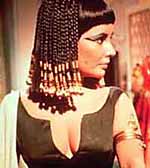 Kind of weak, I'm sorry to report. While she's not a bad actress, she's a contemporary actress, and her thrashings as Cleopatra seem more appropriate to a Tennessee Williams play — particularly in the presence of such Shakespearean stalwarts as Burton. Putting it another way: I didn't believe for a second that Taylor/Cleopatra could convince Burton/Antony to go to war with Rome any more than I believe Taylor could convince Burton to put down a scotch and soda.
Kind of weak, I'm sorry to report. While she's not a bad actress, she's a contemporary actress, and her thrashings as Cleopatra seem more appropriate to a Tennessee Williams play — particularly in the presence of such Shakespearean stalwarts as Burton. Putting it another way: I didn't believe for a second that Taylor/Cleopatra could convince Burton/Antony to go to war with Rome any more than I believe Taylor could convince Burton to put down a scotch and soda.
That said, as an inteviewee suggests in the making-of documentary on Disc Three, Cleopatra contains the exact moment at which Elizabeth Taylor, Actress became Elizabeth Taylor, Camp Icon — i.e., the exact moment at which she cemented her place in pop-culture history.
It happens, of course, during the infamous Procession-into-Rome sequence — easily the most Super Bowl halftime show-ish part of the movie. Even in an era of digital spectacle, this is still a sight to behold: horses followed by chariots followed by streamers followed by archers followed by a woman wearing pasties (yes, pasties) followed by African dancers followed by witch doctors followed by pole-vaulters followed by confetti showers followed by women with giant cardboard wings on their arms followed by birds bursting (on cue) out of an obelisk followed by a Roman band followed by a cavalry followed by a giant Sphinx pulled by 200 or so slaves. On top of this Sphinx sits Ms. E. Taylor — who is then carried down some gold steps (while seated on a gyroscopic platform) and placed before Caesar.
At which point she winks. And her place in narcissism-enabling pop culture is secured.
* * *
V. What else is good?
(1) The way Mankiewicz avoids repeating himself. He'd already made a film of Julius Caesar (with Brando as Antony) in 1953, don't you know — and so he sidesteps the whole "Et tu, Brute?" assassination sequence by re-staging it as a trippy black-magic hallucionation Cleopatra has while in private conference with her court magician.
(2) Harrison, Burton and Roddy McDowall (as Julius Caesar's successor, the neurasthenic Octavian). They almost match the scope of the film, thanks to their utterly appropriate Heston-level gesticulations.
(3) The score by the legendary Alex North. It's overwrought, slithery, and chock full of layers and overdubs. You can also finally get it on a deluxe soundtrack CD, BTW; read more about it here, at Film Score Monthly; Lukas Kendall sums up its greatness better than I ever could.
* * *
VI. And the extras?
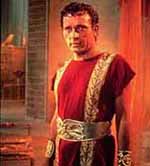 Well, first off there's a mammoth commentary track featuring Joseph L. Mankiewicz's sons Tom and Chris, Martin Landau and "Cleopatra expert and former Fox executive" Jack Brodsky. It re-hashes (in slightly greater detail than the documentary, described below) the production's troubled history. That said, there's a fair-sized silent patch toward the end, and the commentary fails to relate to the onscreen action at important junctures — i.e., a crucial dramatic moment will be transpiring onscreen and one of the Mankiewicz boys will be talking about a random production-woe anecdote. Still, anyone who gamely tries to spin yarns for four solid hours is a pip in my book.
Well, first off there's a mammoth commentary track featuring Joseph L. Mankiewicz's sons Tom and Chris, Martin Landau and "Cleopatra expert and former Fox executive" Jack Brodsky. It re-hashes (in slightly greater detail than the documentary, described below) the production's troubled history. That said, there's a fair-sized silent patch toward the end, and the commentary fails to relate to the onscreen action at important junctures — i.e., a crucial dramatic moment will be transpiring onscreen and one of the Mankiewicz boys will be talking about a random production-woe anecdote. Still, anyone who gamely tries to spin yarns for four solid hours is a pip in my book.
The remainder of Cleopatra's extras are vacuum-packed onto a third disc, tucked away (rather maddeningly and scratch-invitingly) in the liner-notes booklet. This disc contains truly marvelous bonus materials — among the best I've encountered in a single DVD package. They're abundant, informative, historically intriguing, and deeply, powerfully sad, for reasons I'll try to explain later.
Tucked under the "Documentary and Featurette" menu we find the true centerpiece of this edition — a two-hour, warts-and-all making-of saga titled Cleopatra: The Film that Changed Hollywood. If you don't buy/rent this disc, be sure to catch the doc when it airs (debuting April 3, 2001) on American Movie Classics; it's one hell a story, and considerably more tragic and human and reversal-filled than Cleopatra itself. (In fact, if it had less glossy production value and more of the home-movie intimacy of, say, Eleanor Coppola's Hearts of Darkness, I'd be tempted to rank it as the best behind-the-scenes documentary I'd ever seen. As it stands, it's right up there.)
Directed by Kevin Burns and Brent Zacky and narrated by Robert Culp, this documentary (which should be chapter-searchable, but isn't) probably merits its own separate review. Suffice to say, it's a simply appalling saga of waste and mismanagement and Fitzcarraldo-level hubris — only in this case the filmmakers tried to haul the steamboat over the mountain two or three times instead of once. Among the treasures and gossip:
- Extensive footage from the first mammoth, crumbling Alexandria set (used by the film's first director, Rouben Mamoulian), which Mankiewicz ordered scrapped and rebuilt because it wasn't grand enough;
- Test-screen footage of costumes and actors, including a young Joan Collins looking very promising indeed as Cleopatra;
- Interviews with Martin Landau, Roddy McDowall, a ghoulish-looking Richard Zanuck, the surviving Mankiewicz family, Hume Cronyn and a host of cast, crew, friends and associates — all of whom seem bemused and/or bitter about the whole experience;
- Tons of excised footage and assorted cinematic boners, including some shabby battle scenes that Darryl F. Zanuck ordered re-shot after he dramatically seized command at Fox during the Cleopatra debacle;
- Sad tales of (a) Elizabeth Taylor's health crises, (b) Elizabeth's Taylor's absurd, budget-exploding contractual stranglehold on the production and (c) Elizabeth Taylor's public humiliation of husband Eddie Fisher as she dallies with Richard Burton on-set. She's not interviewed for this documentary, and the omission comes as little surprise: The thesis here seems to be that producer Walter Wanger's hiring of Taylor was the fulcrum that sent Cleopatra tumbling into chaos;
- And, saddest of all, tales of the production's personal toll on the talented Mankiewicz, who single-handedly worked to save script and film from ruin — and, for his trouble, had to be given a series of injections to combat his relentless exhaustion. There's something incredibly moving about Mankiewicz's eventual admission that — despite his Herculean efforts in the face of corruption and studio interference — he'd made a movie that was merely good, not great. This, to my thinking, is the documentary's most powerful, frightening moment: Its frank examination of the hard truth that, despite our best efforts, we may end up producing mediocre art.
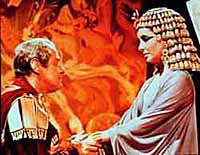 I'm just scratching the surface here: I didn't even mention the rehearsal footage or the fight over the poster art or the brief deconstruction of the film's camp value or the archival TV interviews or the stuff about the movie's very real impact on fashion and pop culture or the extent of the tales of corruption and waste. It's brilliant stuff, and it casts a pall over everything else in this three-disc set — including, I'm afraid, the film itself, which you come to realize turned out surprisingly well despite emerging from a galactic train wreck.
I'm just scratching the surface here: I didn't even mention the rehearsal footage or the fight over the poster art or the brief deconstruction of the film's camp value or the archival TV interviews or the stuff about the movie's very real impact on fashion and pop culture or the extent of the tales of corruption and waste. It's brilliant stuff, and it casts a pall over everything else in this three-disc set — including, I'm afraid, the film itself, which you come to realize turned out surprisingly well despite emerging from a galactic train wreck.
Speaking of palls cast: The remainder of the extras are devoted largely to the marketing of Cleopatra. Viewed in one sitting, they engender emotions of nearly unbearable woe. Allow me to explain.
First up, there's the 1963 featurette, "The Fourth Star of Cleopatra", a nine-minute, remarkably scratch-free (though faded) Movietone News promotional short. Allow me to quote from the narration: "This is the fabulous story behind the fabulous film about the fabulous woman!" The resulting short film plays like a tour of Imelda Marcos' closet — because, in early-'60s Hollywood marketing, backing up assertions of fabulousness apparently means telling us again and again how big, how epic and most of all how plentiful everything is. Twenty-six thousand costumes! Eight thousand pairs of shoes! Fifteen thousand bows! One hundred fifty thousand arrows! The more hysterical sections of North's score are layered over the narration, and this is where the feeling of being buried under the sheer weight of Cleopatra's marketing begins.
But it doesn't end there. Oh, no. Then there's the "Still Gallery," a section haphazardly subdivided into "Costume Concept and Research," "Excepts from Original Exhibitors Campaign Book and Manual," "Excerpts from the Original Commemorative Theater Program," "British Lobby Cards" and "Billboard Art, Miscellanous Keyart, and Japanese Poster." There are hundreds of stills here — a couple of them shimmering in the most eyestrain-inducing fashion imaginable, thanks (I believe) to the "moray" effect of scanning something that's already been dot-screened. Anyway. The costume sketches are gorgeous and important; the rest are production stills, poster art and assorted other promotions, including a coloring-contest entry form. At this point, the viewer's head begins to swim.
But the real moment of overkill — the moment at which the aforementioned unbearable woe gets a foothold — comes somewhere during the viewing of the "Theatrical Trailers and Movietone News" menu.
Here we find newsreel coverage (4:00) of the New York premiere (with 10,000 Noo Yawkers in attendance), plus another newsreel (2:19) featuring the L.A. and D.C. premieres (and higher-ranking celebs in attendance). These two "news stories" play remarkably like "Entertainment Tonight" pieces — particularly in their disguising of shameless marketing ploys as bona fide news items. After viewing these, I came to realize that film scribes who argue that the concept of cross-marketing "synergy" began in the 1980s have a woefully shaky grasp on film history.
And finally, providing an exclamation point to the building nausea, we stumble across six (six!) trailers — one in French, one in Portuguese — ranging from :30 to 4:38 in length. In keeping with Hollywood marketing of the period, these are largely text-driven — and said text is devoted solely to the promise of spectacle. Over shrieking Alex North score snippets we read: "The Festival of Bacchus!" "The Battle of Actium!" "Cleopatra's Fabled Golden Barge!" and, most telling, "The Most Important Event in Entertainment History!"
It's that last tag that finally nailed me — coming as it does atop a pile of tragedy and excess and in the service of plodding drama. Is "Entertainment" really so "Important" that it should consume lives, careers, and over $200M in today's dollars? Is writing such bloat (or, even worse, writing about the writing of such bloat) really a worthy avocation? And would I have bought into the hysteria in 1963 and purchased a ticket?
At least one answer, I'm afraid, is "Absolutely."
— Alexandra DuPont
dupont@dvdjournal.com



- Color
- Three-disc set
- Anamorphic widescreen (2.35:1)
- English 5.1, English Surround, French Surround
- English, Spanish subtitles
- Commentary track featuring Joseph L. Mankiewicz's sons Tom and Chris, Martin Landau, and "Cleopatra expert and former Fox executive" Jack Brodsky
- 2000 documentary: Cleopatra: The Film that Changed Hollywood
- 1963 featurette: The Fourth Star of Cleopatra
- Two Movietone Newsreels on the East Coast and West Coast premieres of Cleopatra
- "Costume Concept and Research" still gallery
- "Excerpts from Original Exhibitors Campaign Book and Manual" still gallery
- "Excerpts from Original Commemorative Theater Program" still gallery
- "British Lobby Cards" still gallery
- "Billboard Art, Miscellaneous Keyart, and Japanese Poster" still gallery
- Six theatrical trailers
- Dual-DVD keep-case (with third disc in booklet pocket)
